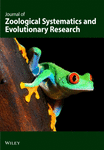A mathematical model of the structure and the dynamics of Rana ridibunda/esculenta-♂ ♂-populations (Anura, Ranidae)
Abstract
Following Graf's (1986) mathematical model regarding the population genetics of Rana lessonae/ esculenta populations, we carried out calculations on the structure and dynamics of R. ridibundal esculenta-♂ ♂-populations, in which R. ridibunda individuals of both sexes live together with esculenta-♂ ♂. Within the context of available biological data on the frog populations, the adjustment and maintenance of a polymorphic equilibrium between the genotypes that live in this system can be attributed to two theoretical possibilities:
- 1
. The establishment of a stable equilibrium is possible if the reproductive chance of either ♂-forms deteriorates with its numerical increase (negative feedback).
- 2
. The fitness parameters are not constant, but depend on ecological and population-specific genetic factors. R. ridibunda/esculenta-♂ ♂-populations may have originated and can remain stable in those areas, in that the fitness of both ♂ ♂-forms is nearly equal. Oscillations of ecological factors, e. g. climate, may influence single fitness components and may lead to temporal advantages of one of the ♂-forms. In this way the equilibrium state could be realised by a reciprocal advantage of one or the other form.
Zusammenfassung
Auf der Basis eines mathematischen Modells (Ansatz nach Graf 1986) wurden Berechnungen zur Struktur und Dynamik von ridibunda/esculenta-♂ ♂-Populationen, in denen neben ridibunda-Individuen beiderlei Geschlechts ausschließlich esculenta-♂ ♂ leben, durchgeführt. Die Einstellung und Aufrechterhaltung eines polymorphen Gleichgewichtes zwischen den in diesem System auftretenden Genotypen kann im Kontext mit vorliegenden populationsbiologischen Daten auf zwei theoretische Möglichkeiten zurückgeführt werden:
- 1
. Die Einstellung eines stabilen Gleichgewichtes ist möglich, wenn sich mit zunehmendem Anteil einer ♂-Form in der Population deren Chancen zur weiteren Reproduktion verschlechtern.
- 2
. Die Fitness-Parameter sind keine Konstanten, sondern hängen von ökologischen sowie populationsspezifischen genetischen Faktoren ab. Ridibunda/esculenta-♂ ♂-Populationen können nur dort entstehen und existieren, wo die Fitness der beiden ♂ ♂-Formen etwa gleich ist. Schwankungen ökologischer Faktoren, z. B. des Klimas, könnten einzelne Fitness-Komponenten beeinflussen und somit zu zeitweiligen Vorteilen für eine ♂-Form führen. Der Gleichgewichtszustand könnte auf diesem Weg durch eine wechselseitige Bevorteilung der einen oder anderen Form gewährleistet werden.




